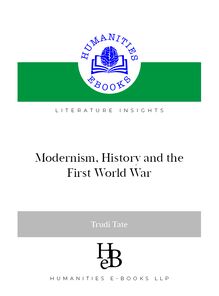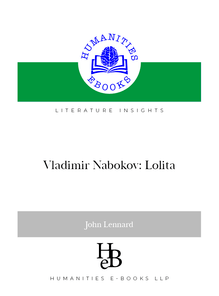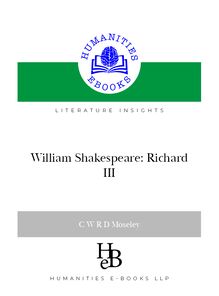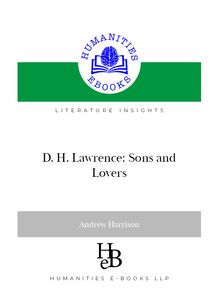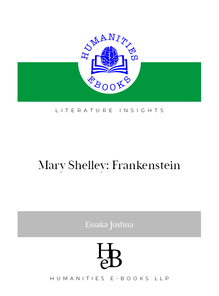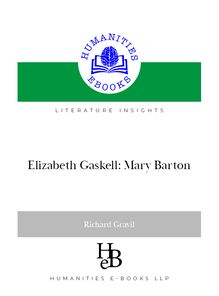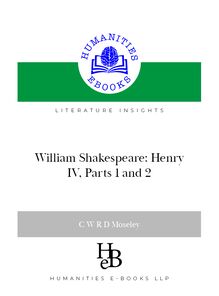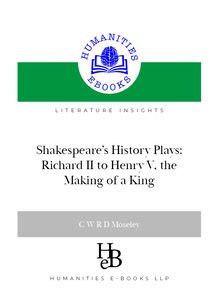-
 Univers
Univers
-
 Ebooks
Ebooks
-
 Livres audio
Livres audio
-
 Presse
Presse
-
 Podcasts
Podcasts
-
 BD
BD
-
 Documents
Documents
-
- Cours
- Révisions
- Ressources pédagogiques
- Sciences de l’éducation
- Manuels scolaires
- Langues
- Travaux de classe
- Annales de BEP
- Etudes supérieures
- Maternelle et primaire
- Fiches de lecture
- Orientation scolaire
- Méthodologie
- Corrigés de devoir
- Annales d’examens et concours
- Annales du bac
- Annales du brevet
- Rapports de stage
La lecture à portée de main
114 pages
English
Découvre YouScribe en t'inscrivant gratuitement
Je m'inscrisDécouvre YouScribe en t'inscrivant gratuitement
Je m'inscris
Obtenez un accès à la bibliothèque pour le consulter en ligne
En savoir plus
En savoir plus
114 pages
English
Obtenez un accès à la bibliothèque pour le consulter en ligne
En savoir plus
En savoir plus

Description
/LWHUDWXUH ,QVLJKWV *HQHUDO (GLWRU &KDUOHV 0RVHOH\ :LOOLDP 6KDNHVSHDUH .LQJ /HDU -RKQ /HQQDUG ´«%\ WKH HQG DOPRVW HYHU\RQH LV GHDG RU EURNHQµ +(%Ɓ)25 $'9,&( 21 7+( 86( 2) 7+,6 (%22. 3/($6( 6&52// 72 3$*( Readingt *This book is designed to be read in single page view, using the ‘fit page’ command. *To navigate through the contents use the hyperlinked ‘Bookmarks’ at the left of the screen. *To search, click the magnifying glass symbol and select ‘show all results’. *For ease of reading, use to enlarge the page to full screen, and return to normal view using . *Hyperlinks (if any) appear in Blue Underlined Text. Permissions Your purchase of this ebook licenses you to read this work onscreen. No part of this publication may be otherwise reproduced or transmitted or distributed without the prior written permission of both the copyright owner and the publisher. You may print one copy of the book for your own use but copy and paste functions are disabled. Making or distributing copies of this book would constitute copyright infringement and would be liable to prosecution. Thank you for respecting the rights of the author. Literature Insights General Editors: C. W. R. D.
Sujets
Informations
| Publié par | Humanities eBooks |
| Date de parution | 11 janvier 2021 |
| Nombre de lectures | 0 |
| EAN13 | 9781847601742 |
| Langue | English |
| Poids de l'ouvrage | 1 Mo |
Informations légales : prix de location à la page 0,0200€. Cette information est donnée uniquement à titre indicatif conformément à la législation en vigueur.
Extrait
Literature Insights General Editor: Charles Moseley
William Shakespeare King Lear
John Lennard
“…By the end almost everyone is dead or broken”
HEB☼FOR ADVICE ON THE USE OF THIS EBOOK PLEASE SCROLL TO PAGE 2
Readingt
*This book is designed to be read in single page view, using the ‘fit page’ command. *To navigate through the contents use the hyperlinked ‘Book-marks’ at the left of the screen. *To search, click the magnifying glass symbol and select ‘show all results’. *For ease of reading, use <CTRL+L> to enlarge the page to full screen, and return to normal view using < Esc >. *Hyperlinks (if any) appear in Blue Underlined Text.
Permissions
Your purchase of this ebook licenses you to read this work on-screen. No part of this publication may be otherwise reproduced or transmitted or distributed without the prior written permission of both the copyright owner and the publisher. You may print one copy of the book for your own use but copy and paste functions are disabled. Making or distributing copies of this book would constitute copyright infringement and would be liable to prosecution. Thank you for respecting the rights of the author.
Literature Insights General Editors: C. W. R. D. Moseley
William Shakespeare:King Lear
John Lennard
HEB ☼ Humanities-Ebooks, 2010
Copyright
© John Lennard, 2010
The Author has asserted his right to be identified as the author of this Work in accordance with the Copyright, Designs and Patents Act 1988.
First published byHumanities-Ebooks, LLP, Tirril Hall, Tirril, Penrith CA10 2JE
ISBN 9781847601742 Pdf ISBN 9781847601759 Kindle
Contents
A Note on the Author
Acknowledgements
Preface 0.1 Introduction 0.2 A note on the texts ofKing Lear 0.3 Acts and scenes in the Q1 and F1 texts Part 1. Approaching Shakespeare 1.1 A Man of the Jacobethan Theatre 1.2 Companies—Actors—Stages—Audiences 1.3VenusandLucrece 1.4ErrorsandTwo Gents Part 2. ApproachingKing Lear 2.1 Fathers and Daughters and Fools 2.2 Unity and Division 2.3 A Play by Shakespeare Part 3. Actors and Players 3.1 Lear 2.2 Goneril 2.3 Regan 2.4 Cordelia 2.5 Albany 2.6 Cornwall 2.7 Burgundy and France 2.8 Kent/Caius 2.9 Gloucester
2.10 Edmund 2.11 Edgar/Poor Tom 2.12 Oswald 2.13 The Fool 3.14 Gentlemen, servants, &c.. Part 4. Acts and Devices 4.1 Acts 4.2 Scenes 4.3 Soliloquy and Colloquy 4.4 Verse, Prose, and Song 4.5 Metatheatre 4.6 Doubling 4.7 Special Effects 4.8 Exits Part 5. Comedic Agony andKing Lear
Part 6. Critics’ Corner 6.1 Bibliography 6.2 Major films ofKing Lear 6.3 Web-sites
A Note on the Author
Born and raised in Bristol, UK, John Lennard took a B.A. and D.Phil. at New College, Oxford, and an M.A. at Washington University in St Louis. He has taught for the Universities of London, Cambridge, and Notre Dame, the Open University, and Fairleigh Dickinson University on-line; he was from 2004–09 Professor of British and American Literature at the University of the West Indies—Mona. His publications includeBut I Digress: The Exploitation of Parentheses in English Printed Verse(Clarendon Press, 1991),The Poetry Handbook(OUP, 1996; 2/e 2005), with Mary LuckhurstThe Drama Handbook(OUP, 2002),Of Modern Dragons and other essays on Genre Fiction(HEB, 2007; Troubadour 2008), andOf Sex and Faerie: Further Essays on Genre Fiction2010). He is General (HEB/Troubadour, Editor of HEB’s Genre Fiction Sightlines and Monographs series, for which he has written on Reginald Hill, Walter Mosley, Octavia E. Butler, Ian McDonald, and Tamora Pierce. For Literature Insights he has also written onHamlet, Vladimir Nabokov’sLolita, and Paul Scott’sRaj Quartet&Staying On.
Acknowledgements
My oldest debt is to Richard Camp, then of Bristol Grammar School, who first taught meKing Learback in the day, and my longest running debt is to the actors and directors of productions I have been fortu-nate enough to attend, for bringing the play so painfully to life. More proximately, for my adult professional understanding of Shakespeare I owe most to Anne Barton, the late Tony Nuttall, Peter Holland, Adrian Poole, Charles Moseley, and David Edgar. Most proximately I must thank Treena Balds, who undertook the initial line-counts for me and (like Charles Moseley and John Gilroy) read the whole with a sharp eye.
Preface
0.1 Introduction
For much of its four centuries of stage-lifeKing Learhas (like Lear’s daughters) been something of a problem child. Dr Johnson com-plained that “the extrusion ofGloucester’seyes […] seems an act too horrid to be endured in dramatick exhibition” and, more seriously, alleged as a moral failing that “Shakespearehas suffered the virtue ofCordeliato perish in a just cause, contrary to the natural ideas of justice, to the hope of the reader, and, what is yet more strange, to 1 the faith of chronicles”. This view was so widely shared that from the later seventeenth to mid-nineteenth centuries the preferred text for performance was an adaptation by Nahum Tate (1652–1715) in which only villains die, Lear regains his throne, the Fool is omit- ted, and Cordelia marries Edgar in a redemptive comedic ending. Today this seems strange, even absurd, but debates around the cau-tious, piecemeal restoration of Shakespeare’s version to the stage in the early-mid nineteenth century give pause. Many spectators were as honestly appalled as Johnson by Cordelia’s death, and simply baf-fled by the Fool—a clear warning to all of the degree to which public sensibility and theatrical performances change, decade by decade. Then again, once ‘Shakespeare’s version’ was restored as the nor-mative text for study and performanceKing Lear grew in public and critical reputation until in the later twentieth century it came to
Samuel Johnson, ‘Notes onKing Lear’ from his edition of 765, reprinted in e.g. W. K. Wimsatt, ed.,Samuel Johnson on Shakespeare(New York: Hill & Wang, 960; asDr Johnson on Shakespeare, Harmondsworth: Penguin, 969). Tate’s play is collected in Sandra Gilbert, ed.,Shakespeare Made Fit(London: Dent, 997). The actor-managers who did so were Edmund Kean (789–8), in 8; William Charles Macready (79–87), in 88; and Samuel Phelps (804– 78), in 845.
10
Shakespeare:King Lear
eclipseHamletas his ‘greatest tragedy’—a play that, likeTroilus and Cressida, appealed precisely in its extremity of violence and unre-mitting bleakness of vision to sensibilities battered by the horrors of 1 two world wars.Yet in the last 30 or so years the very intensity of attentionKing Learnow attracts has sparked a sometimes bitter and often noisy debate about what exactly Shakespeare’s text is, or was, and how it should be printed—an apparently abstruse set of scholarly questions that lies at the centre of what has become the single most consequential argument in modern Shakespeare studies. Nor can stu-dents of the play practically avoid this textual question, for the pur-chaser of any recent annotated edition is certain to find the text pref-aced by an editorial note that is longer and weightier than usual, and may well find themselves confronted either by pages that fairly bris-tle with textual notes, or not byatext at all, but two (or even three) significantly differing texts, that may be given (perhaps in parallel) in one volume or split the edition into distinct volumes offering dis-tinct texts. For a series like theseLiterature Insights, by policy determinedly short and far more concerned with practical study of literature than scholarly disputeper se, this textual battle poses a problem. Students want clear, straightforward discussion of substance, not a constant gibber of notes and caveats about textual issues; but alas, such issues are like the quality of air—while all is well one hardly notices them, but if it is ill they become a pressing urgency, affecting everything to claim priority. I therefore necessarily begin with my own longer-and-weightier-than-usual ‘Note on the Text’ to explain what is at stake—a set-up essential to the discussions that follow. But thereafter schol-arly problems are ruthlessly relegated to notes, while links in the bib-liography make available to interested readers the primary materials, that they may see the evidence for themselves. A word is necessary about casting in the King’s Men, Shakespeare company, who premieredKing Lear, probably in 1604–05. All cast-ing matters are tricky, for there is almost no evidence about the first casting of any of Shakespeare’s plays and most of what is said is
See R. A. Foakes,Hamlet versus Lear: Cultural Politics and Shakespeare’s Art(Cambridge: Cambridge University Press, 99).
-
 Univers
Univers
-
 Ebooks
Ebooks
-
 Livres audio
Livres audio
-
 Presse
Presse
-
 Podcasts
Podcasts
-
 BD
BD
-
 Documents
Documents
-
Jeunesse
-
Littérature
-
Ressources professionnelles
-
Santé et bien-être
-
Savoirs
-
Education
-
Loisirs et hobbies
-
Art, musique et cinéma
-
Actualité et débat de société
-
Jeunesse
-
Littérature
-
Ressources professionnelles
-
Santé et bien-être
-
Savoirs
-
Education
-
Loisirs et hobbies
-
Art, musique et cinéma
-
Actualité et débat de société
-
Actualités
-
Lifestyle
-
Presse jeunesse
-
Presse professionnelle
-
Pratique
-
Presse sportive
-
Presse internationale
-
Culture & Médias
-
Action et Aventures
-
Science-fiction et Fantasy
-
Société
-
Jeunesse
-
Littérature
-
Ressources professionnelles
-
Santé et bien-être
-
Savoirs
-
Education
-
Loisirs et hobbies
-
Art, musique et cinéma
-
Actualité et débat de société
- Cours
- Révisions
- Ressources pédagogiques
- Sciences de l’éducation
- Manuels scolaires
- Langues
- Travaux de classe
- Annales de BEP
- Etudes supérieures
- Maternelle et primaire
- Fiches de lecture
- Orientation scolaire
- Méthodologie
- Corrigés de devoir
- Annales d’examens et concours
- Annales du bac
- Annales du brevet
- Rapports de stage
Signaler un problème
YouScribe
Le catalogue
Le service
© 2010-2024 YouScribe
